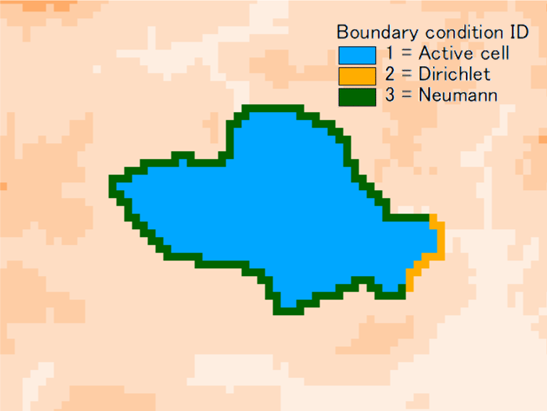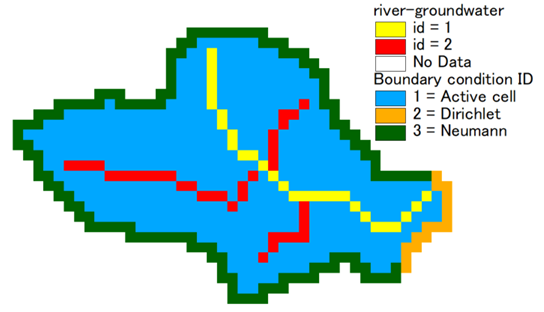12. Groundwater#
The FEST model can simulate groundwater flow with a quasi 3D
scheme based on macroscopic cellular automata [Ravazzani et al., 2011].
Groundwater is simulated as one or more aquifers that can interact through
an aquitard. Aquitard depth is computed as the difference between bottom
of upper aquifer and top of lower aquifer. Aquifers are enumerated starting
from number 1 at top. At least one aquifer must be present in order to
simulate groundwater. Optionally, the mutual flux exchange between
river and groundwater can be simulated.
Groundwater simulation is activated by filling in the specific
section in the main configuration file ( Section 3.11 ).
This chapter describes the groundwater configuration file, usually named groundwater.ini.
Aquifers configuration is explained in Table 12.1, river-groundwater
interaction is explained in Table 12.2
Keyword |
Description |
Requirements |
|---|---|---|
|
Number of aquifers in the groundwater basin |
Mandatory |
|
Section that configure the aquifer number n with n = 1, aquifers. |
Mandatory |
|
Map of boundary condition and active cells definition. Available options: 1 = active cell, 2 = Dirichlet type boundary condition (assigned head), 3 = Neumann type boundary condition (flux assigned) |
Mandatory. The user can set a map with usual file, format, and epsg keywords, or he can assign a constant value using the scalar keyword |
|
Map of boundary condition head values to be assigned to cells of Dirichlet type boundary condition (id = 2). For Neumann type boundary condition cells (id = 3), a flux is assigned internally at every time step from the soil water balance module. |
Mandatory. The user can set a map with usual file, format, and epsg keywords, or he can assign a constant value using the scalar keyword. This map can change in time by assigning a netCDF multitemporal layer. In this case the user can set |
|
Top of the aquifer. |
Mandatory. The user can set a map with usual file, format, and epsg keywords, or he can assign a constant value using the scalar keyword |
|
Bottom of the aquifer |
Mandatory. The user can set a map with usual file, format, and epsg keywords, or he can assign a constant value using the scalar keyword |
|
Aquifer hydraulic conductivity (m/s) |
Mandatory. The user can set a map with usual file, format, and epsg keywords, or he can assign a constant value using the scalar keyword |
|
Aquifer specific yield (m/m) |
Mandatory. The user can set a map with usual file, format, and epsg keywords, or he can assign a constant value using the scalar keyword |
|
Aquitard hydraulic conductivity (m/s) |
Required when more than one aquifer are simulated. The last (lower) aquifer does not need aquitard definition. The user can set a map with usual file, format, and epsg keywords, or he can assign a constant value using the scalar keyword |
In the next example, one aquifer is configured. boundary-condition-id, initial-head,
and top-elevation, are assigned as raster esri ascii maps. bottom-elevation,
hydraulic-conductivity, and specific-yield, are assigned as a scalar constant.
boundary-condition-value is assigned as a multitemporal net-cdf file with option
sync-initial-time = 1 to start from the proper initial value.
Example of groundwater configuration file.
aquifers = 1
[aquifer_1]
[[boundary-condition-id]]
file = ./data/aquifer1_bc_id.asc
format = esri-ascii
epsg = 32632
[[boundary-condition-value]]
file = ./data/head_bc.nc
format = net-cdf
variable = head
epsg = 32632
sync-initial-time = 1
[[initial-head]]
file = ./data/dem-3m.asc
format = esri-ascii
epsg = 32632
[[top-elevation]]
file = ./data/dem.asc
format = esri-ascii
epsg = 32632
[[bottom-elevation]]
scalar = 50.
[[hydraulic-conductivity]]
scalar = 0.0003
[[specific-yield]]
scalar = 0.3

Fig. 12.1 Example of map to set boundary condition and active cell#
12.1. River-groundwater flux exchange#
Keyword |
Description |
Requirements |
|---|---|---|
|
It starts section to configure river-groundwater interaction |
Optional |
|
Map that defines the cells where river-groundwater interaction is simulated. 1=river-groundwater interaction cell, nodata = no interaction. |
Mandatory. |
|
Map that specifies the river thalweg elevation. It may be different from digital elevation model assigned in Morphological properties section. |
Mandatory |
A table with id = river-groundwater is required to define riverbed
conductivity and thickness. In the following example two maps are
assigned as [[river-id]] and [[river-dem]]. Table river-groundwater
defines two ids with 0.0001 and 0.0003 m/s streambed conductivity,
respectively and a streambed thichness of 1 m. [[river-id]] map is shown in Fig. 12.2
Example of [river-groundwater] section in groundwater configuration file.
[river-groundwater]
[[river-id]]
file = ./data/river_aquifer_id.asc
format = esri-ascii
epsg = 32632
[[river-dem]]
file = ./data/dem-5.asc
format = esri-ascii
epsg = 32632
Table Start
Title: river groundwater exchange parameters
Id: river-groundwater
Columns: [id] [streambed-conductivity] [streambed-thickness]
Units: [-] [m/s] [m]
1 0.0001 1.0
2 0.0003 1.0
Table End

Fig. 12.2 Map of flow accumulation (black cells) and river direction (white arrow) overlayed to boundary condition id map of Fig. 12.1#

Fig. 12.3 Map of flow river-groundwater id overlayed to boundary condition id map of Fig. 12.1#